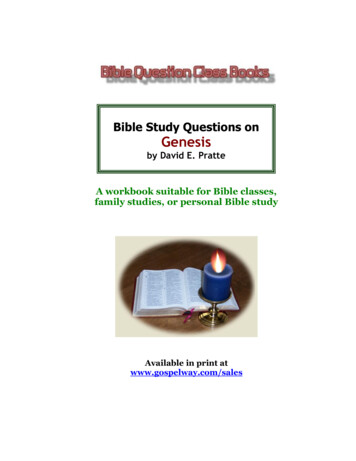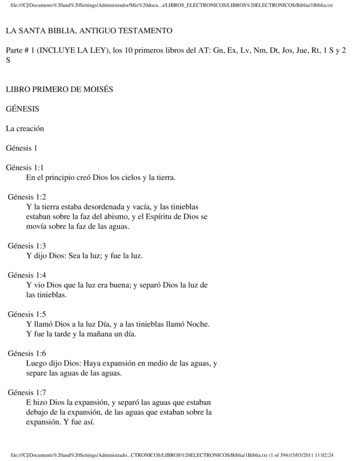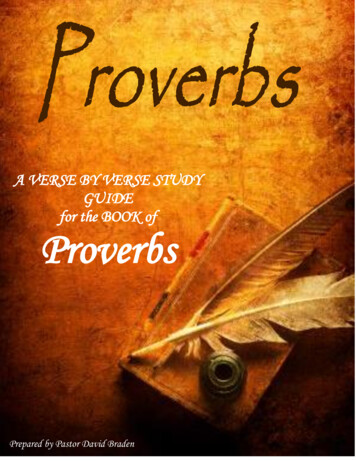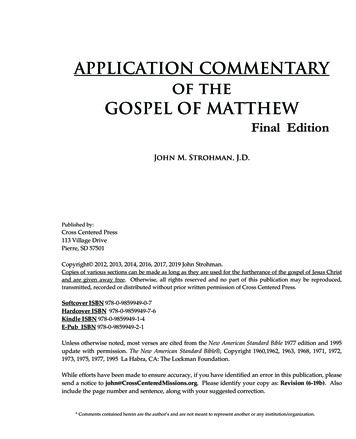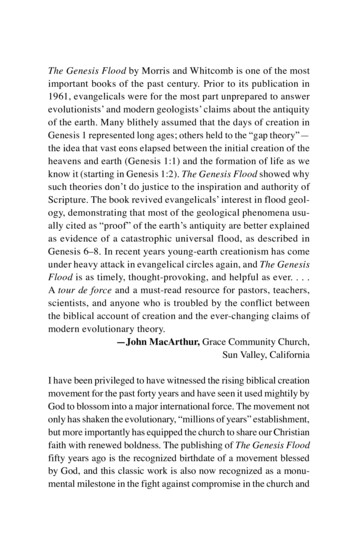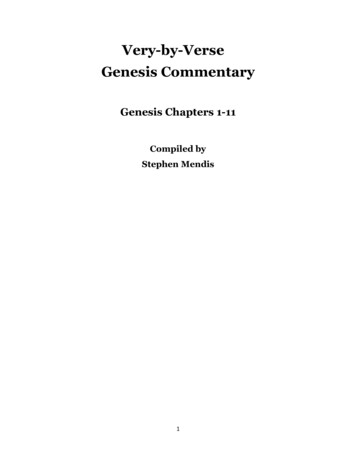
Transcription
Very-by-VerseGenesis CommentaryGenesis Chapters 1-11Compiled byStephen Mendis1
Personal backgroundStephen Mendis is a Christian, originally from Colombo, Sri Lanka. He now lives in Canada. Hisparents grew up in the Roman Catholic church but became part of the Seventh-day Adventist(SDA) church when he was 8 years old. He grew up with the SDA community, and attended SDAschools. He has served in the Sri Lanka Missions of the Seventh-day Adventists as an AssociateYouth Director, a lay preacher, and an adult Sabbath School teacher. He ran his apologetic SDAblog ministry defending and promoting SDA doctrines passionately for nearly 10 years. When hebegan restudying the old and the new testaments, verse by verse, chapter by chapter, book by bookand especially the covenants God made with His people, he discovered that SDA truth is far fromthe Bible truth. There are many good people in the SDA church. The SDA church has beenresponsible for doing many good things around the world especially through their humanitarianprograms in developing countries. But there are some significant theological problems, which cantake years to fully comprehend. In 2015, he withdrew his membership from the SDA church, andnow enjoys sharing the simple Gospel of Jesus Christ as revealed in the Holy Scriptures.Purpose of this Genesis Commentary (Chapters 1-11)This is a compilation, a personal research and study commentary, with references to variousresources (see References), intended to make sense of Genesis chapters 1-11. It is not to bedistributed for profit but to be shared freely to encourage anyone to study the Bible deeply.All Scripture quotations, —except where otherwise noted, —are from The New AmericanStandard Bible.2
ContentsIntroduction . 4Genesis 1:1 The Creation of the Universe “in the beginning” . 5Genesis 1:2-26 The Preparation of the Earth in Six Days. 8Genesis 2:1-4: God’s rest on the seventh day . 29Genesis 2:4-25: God’s work on the 6th day and the Garden of Eden . 32Genesis 3: The Fall of Humanity. 43Genesis 4: Cain and Abel . 56Genesis 5: Adam’s Descendants . 63Genesis 6: God call’s Noah and Man’s wickedness . 67Genesis 7: God’s Judgement with a Flood . 76Genesis 8: Noah and Family Leave the Ark . 82Genesis 9: God’s Covenant with Noah. 87Genesis 10: The Table of Nations. 93Genesis 11: The Tower of Babel. 98Appendix 1: Does Exodus 20:11 show that God created the earth in six days? . 104Appendix 2: Are there gaps in genealogies?. 105Appendix 3: Why is there animal death before the fall of man?. 107References . 1093
IntroductionMoses is traditionally considered the author of Genesis except for a handfulof passages or chapters, which would have been completed by other authorsafter his death. Moses wrote the book of Genesis for the people of Israel,whom he led out of slavery in Egypt back to the land of their forefathers. TheBible seems to argue for around 1445 B.C. date for the Exodus (when Mosesled the Israelites out of Egypt), which could have been around when Mosesbegan to write Genesis.The genre of the opening chapters of Genesis is not to supply scientificinformation to tell us the age the earth or how the heavenly bodies work, butit is to shape and give purpose to the Israelites (to whom it was written andaddressed originally), most of whom were farmers, who came out of a 400year period of slavery in Egypt. They were deeply influenced by that culture,and beliefs about sun and moon deities. We must therefore rememberGenesis is not a science textbook, instead Moses is trying to explain the worldas he sees it, based on historical accounts and records that were perhapsorally passed from Adam to Patriarchs and generations that followed, whichthe Holy Spirit inspired and guided him to write.In biblical interpretation, we must adhere to the law of the first reader whichmeans you always try to take the biblical truth through the grid of the firstreaders. What would they have understood? How would they have processedit before we jump to our own cultural context. The fact is that the ancientIsraelites were not modern 21st century Americans. They were not wrestlingwith the modern scientific questions we wrestle with today. They were livingin the ancient Near East, and the ancient Near East was a thoroughly paganand polytheistic culture.Therefore, to the Jews, the original readers of Genesis, it tells them the storyof how God is the author of creation, and how He prepared the land for firsthumans, and how God initiated a personal relationship with their forefatherAbraham. For all readers, Genesis offers a thorough background to the restof the Bible. We learn of the fall of man, of its destructive effect on humanity,and of God’s plan to atone for that sin through a future coming seed, theMessiah.4
Genesis 1:1 The Creation of the Universe “in the beginning”Genesis 1:1 The Creation of the Universe “in the beginning”In the beginning God created the heavens and the earth (Genesis1:1).In the beginning. The Hebrew word reshit translated "beginning" has avery specific sense in Scriptures. The term does not mean an instant of timebut an "unspecified period of time". For example, this Hebrew word is usedin Job 8:7 this way: “Though your beginning (reshit) was insignificant, yetyour end will increase greatly”. Here, the word “beginning” refers not to asingle moment in Job's life, but to the "early part of Job's life” before hismisfortunes overtook him. Therefore, the term reshit refers to an extended,yet indeterminate duration of time and not a specific moment. We cannotsay for certain when this “beginning” was or how long it was, in relation tocreation. Therefore, this “beginning” leaves open both the possibilities of ayoung and an old earth.God created. It is God who created (bara) all this in the beginning. Theancient Hebrew word bara (created) generally means to create out ofnothing, showing that God created the world out of nothing. The otherHebrew word used in a creative sense in Genesis is asah, translated “make”or “made”, which generally means “to fashion or shape”, “to appoint” or “tomake something suitable” or “to function” in a certain way. Bara emphasizesthe initiation of an object, whereas Asah emphasizes the shaping of anobject or “appointing” of an object to function in a certain way. Thisdistinction will be useful as we read the rest of the Genesis chapter 1.It is God who created “in the beginning”. God Himself was before thebeginning (Psalm 93:2). At some time before the beginning, God also createdthe angels, because they witnessed the creation of the heavens and the earth(Job 38:7). It must be noted also that Lucifer and his angels fell into sin sometime after they were created but before the creation of man (Ezekiel 28:15).The fall of Lucifer will be relevant in our understanding of Genesis.Who is this God? In the Hebrew, the word translated “God” is Elohim.Elohim is the plural form of El or Eloah. The name Elohim means strengthand might. It is the common Hebrew term for God. It is also used of falsegods. However, the plural noun Elohim is always used with a singular verb(seemingly contrary to the rules of grammar) when it speaks of the true God.This indicates a unity and diversity within the nature of God. El is used5
Genesis 1:1 The Creation of the Universe “in the beginning”for the Father (Genesis 14:18), the Son (Isaiah 7:14), and the Holy Spirit (Job33:4). Given the unity and diversity within the nature of God, the rest of theBible attributes “creation” of all things to; speaking of the Father, it is said,“the Father, from whom all things came’ (1 Timothy 2:5). Speaking of theSon, “For by Him [Son] all things were created, both in the heavens and onearth” (Colossian 1:16). Speaking of the Holy Spirit, “By His Spirit Headorned the heavens” (Job 26:13).The heavens and the earth. God created (bara) “the heavens and theearth” in the beginning in an unspecified period of time. The phrase“heavens and earth” is a Hebraic way of saying “everything” or the entireuniverse. When the phrase “heavens and earth” is used together, it is used asa “merism”. A merism expresses 'totality' by combining two contrasts or twoextremes. Unlike English, Hebrew does not have a single word to express theconcept of 'the universe'; it must do so by means of a merism. Therefore, theexpression “heavens and earth” (also translated as “sky and land”) stand forthe “entirety of the universe”. It is “everything” from the skies above tothe earth below. It is like saying from top to bottom or head to toe. If Isaid head to toe, it includes not just my head and toes, but all other bodyparts (hands, knees, feet etc.). Similarly, “heavens and earth” included spacetime, mass-energy, and the laws that govern them, even the sun, moon, andthe stars, vegetation, and all the animals.SummaryGenesis 1:1 reveals that God created the entire universe including the earth,and all that is in them (sun, moon and the starts, vegetation and animals),during an unspecified period or point in time. What God does not tell us herein Genesis 1:1 is very important. He does not tell us how long or when thiscreation took place, but it took place in a period of time called “in thebeginning”. Therefore, this “beginning” leaves open both the possibilities ofa young and an old earth. Because God does not answer any of thesequestions. We can only examine the physical evidence from geology andastronomy and come to our own conclusions on these matters.Understood this way, the Bible has no quarrel with the scientific evidencethat suggests the universe and the earth is old. By the way, God has twospheres of revelation: The Bible (special revelation) and nature (general6
Genesis 1:1 The Creation of the Universe “in the beginning”revelation). What God reveals in nature can never contradict what he revealsin Scripture, and what he reveals in Scripture can never contradict what hereveals in nature. He is the author of both forms of revelation, and God doesnot contradict himself.7
Genesis 1:2-26 The Preparation of the Earth in Six DaysGenesis 1:2-26 The Preparation of the Earth in Six DaysGenesis 1:1 revealed that God created the universe during an unspecifiedperiod of time called, “in the beginning”.Now Genesis 1:2 onwards speak of a time after the creation of the universewhen God prepared the earth for Adam and Eve in six days. You will seethat from Genesis 1:2 onwards, the focus of the six days of creation appearsto be not bara but asah. It is not the idea of “initiating creation”, but the ideaof “fashioning or shaping,” or “to make something suitable” or “appointingsomething to function” using existing created order.It is preparation of the earth [land] for human habitation for the firsttime. This will be made clear, because “the earth”, and “waters” already existwhen we reach Genesis 1:2, and onward.And the earth was a formless and desolate emptiness,and darkness was over the surface of the deep, and the Spirit ofGod was hovering over the surface of the waters (Genesis 1:2).The earth. Because the “earth” was created in Genesis 1:1, “in the beginning”,the earth already exists. So, now the focus shifts from “the universe” to "theearth" in the rest of Genesis chapter 1. Hence, Genesis 1:2 does not, then, referto something that God is doing to the whole universe but something that He isdoing on the earth.The word translated as “earth” is the Hebrew word eretz, which can betranslated as land. Eretz can refer to the earth as a whole (Genesis 1:1), an areaof dry land (Genesis 1:10), some particular land area like the Garden of Eden(Genesis 2:5-7) or the specific land promised to Abraham (Genesis 15:18).Therefore, the word translated "earth" (eretz) in Genesis 1:2 can mean alocalized section of the earth, and do not necessarily refer to the wholeplanet earth. Further evidence for this is that many Jewish theologians andChristian scholars believe that Genesis 1:2 and the following verses are referringto the preparation of the promised land (where the Garden of Eden wasplaced), not the entire planet earth.1 If this is the case, then God is preparingthe Promised Land for the first time, for the inhabitation of the human race hewill bring into existence on the sixth day. This is the land “flowing with milkand honey” (Exodus 3:17) that God repeatedly mentions that He will give8
Genesis 1:2-26 The Preparation of the Earth in Six DaysAbraham and Israel later, and the Garden of Eden appear to be within or nearits borders (Genesis 2:10-14;Genesis 15:18).Hence, having affirmed that God is the creator of all things (universe) in Genesis1:1, Moses (the author of Genesis) immediately moves on in Genesis 1:2 toemphasis the work of God in preparing a special place within this creation forhumanity. It is the preparation of a certain land, not the creation of theentire universe, that is recounted in the six days of Genesis 1, as you will see.So, what is the condition of the land God is about to prepare for man?Formless and desolate emptiness. The particular land God is about toprepare for man is said to be “formless” tohu and “desolate” wabohu.“Tohu wabohu” is a Hebrew word that conveys the idea of "uninhabitablewilderness" and not "formless and void chaos”. This is made clear in Jeremiah4:23-26, where tohu wabohu is used to describe the promised land after Israelhad been exiled from it because of their disobedience. "I looked on the earth[land], and behold, it was formless and void (tohu wabohu)” (Jeremiah4:23). Similarly, Deuteronomy 32:10 uses the same phrase (tohu) to describethe wilderness in which Israel wandered for forty years before entering thepromised land: “He found him [Israel] in a desert land, and in the howlingwasteland [tohu] of a wilderness” (Deuteronomy 32:10).Therefore, the idea of “tohu wabohu” is a deserted wilderness, and not aparadise good for mankind's inhabitation. Therefore, “without form and void”does not mean chaos, but it means deserted wilderness. (Now people could havelived in a earth that may have looked liked “tohu wabohu”, or a wilderness, butGod wants to prepare a paradise for the first humans). Therefore, what will Goddo to make this wilderness of a land a paradise for first humans? That appearsto be what God is going to do using the six days of Genesis. He is going to asah(shape) the land, and the sky a habitable paradise for first humans.Darkness was over the surface of the deep. The “deep” is the Hebrewword thom. It can be translated as “deep”, or “deep places”. This deepappears to be referring to the deep places of water that is within or adjacentto this land. It appears that this land area that God was about to prepare wascovered by deep waters (hence uninhabitable). Darkness (hosek) can betranslated as obscurity. There may have been some type of darkness orobscurity that may have existed in the atmosphere or firmament, such aswhat Job mentions, so that no light was getting through : "Where were you9
Genesis 1:2-26 The Preparation of the Earth in Six Dayswhen I laid the foundation of the earth? .When I made a cloud itsgarment, and thick darkness its swaddling band" (Job 38:4-9). Or thisdarkness could also be the absence of “light” at this moment in time, whenGod is about to do His work.The Spirit of God was hovering over the surface of the waters. Thisis the Holy Spirit that Matthew mentions after the Father, and the Son(Matthew 28:18). Although some have read the clause as “a mighty wind”,the traditional reading “Spirit of God” seems to be the only readingcompatible with the verb “hovering,” which is a verb not suited to describingthe blowing of a wind. Moreover, the image of the Spirit of God hovering overthe “deep places of waters” is similar to the depiction of God in Deuteronomy32:11 as an eagle “hovering” over the nest of its young, preparing andprotecting their nest. The Spirit is hovering which signifies a vibrantmoving. Here, God begins to prepare, shape the already existing land intosomething beautiful and suitable for mankind, because this land is full ofdeep places of waters, not ideal for the first humans.You will see that God will prepare the land using six days. The first 3 dayswill be a work of forming, and the last 3 days will be a work of filling. Inall these days, He will be doing a work of preparing, shaping, appointing theland and the skies for man’s benefit. God could have done all of these in asecond if He wanted, but God follows a pattern, an order, as He has a purposein everything He does.Day 1-3: Forming the earth for filling.DAY 1Then God said, “Let there be light”; and there was light (Genesis1:3)Then God said. It was enough for God to merely speak the words. God doesnot “make” on every day as you will see, but He does “speak” on every day.Let there be light. It does not say “God created (bara) light”. “Let therebe" is not a statement of the initial creation (bara), but a statementof appearance or appointing (asah). Remember that in Hebrew, there aredistinct words for create and make. Also remember, Genesis is not a sciencetextbook describing how the earth came to be, instead Moses is trying to10
Genesis 1:2-26 The Preparation of the Earth in Six Daysexplain to us how the earth was prepared by God from his perspective or froma perspective of how it appeared to him.The Hebrew construction “let there be” light does not denote that light nowbegins to exist for the first time, but rather light is to function or be appointedin a certain way. For example, the expression let there be is used in thephrase “Let your favor be upon us” (Psalms 33:22). This obviously is not arequest for God’s favor to begin to exist, but rather to function in a certainway. David poetically says, “O mountains of Gilboa, Let there be no dewnor rain upon you” (2 Samuel 1:21). Here again, “let there be” is used for dewor rain to function in a certain way.Similarly, the sun, moon, stars were already created (bara) in Genesis 1:1(remember the phrase “heavens and earth” included everything in betweenthe heavens and the earth). Therefore, the sun, moon, and stars alreadyexisted, and gave sufficient light to vegetation, and animals to thrive all thistime, but now God commands that the light (probably from the sun) bemade or appointed for a particular function, namely, to mark the “day” and“night” for man’s benefit as you will see in Genesis 1:5 because man is aboutto be made.Just as the significance of the rainbow (Genesis 9:13) was appointed as asymbol of His unending promise for all generations long after it had beencreated, so also God announced His purpose for light, to demarcate “day”for mankind, as you will see.Moreover, when God said, "Let there be light", it may have removed some ofthose thick clouds that caused darkness so that no light was getting through.But now, sun’s light would be made visible and function in a better waysuited for mankind’s habitation.Interestingly, Jeremiah 4:23 describes the condition of the land of Judahunder the devastating destruction that was brought upon it by the judgmentof God, this way: “I looked at the earth, and behold, it was a formless(tohu) and desolate emptiness (wabohu); and to the heavens, and theyhad no light”. Here, “no light” does not mean there was no sun or the moonor stars, but heavens appeared to give no “light”, perhaps from the smoke ofthe destructive fires that blocked the light (Isaiah 9:18,19). Hence, “Let therebe" is not necessarily a statement of the initial creation (bara), but astatement of appearance or appointing (asah).11
Genesis 1:2-26 The Preparation of the Earth in Six DaysThere was light. God spoke and it was so. Light is now appointed for aspecial purpose for mankind. It will mark “day” and “night” as we will soonsee. Moreover, the light from the perspective of the land, had been hiddenbehind dark thick clouds so that no light was getting through. God now madethis light visible (there was light) and appointed it for a purpose.God saw that the light was good; and God separated the light fromthe darkness. God called the light “day,” and the darkness Hecalled “night.” And there was evening and there was morning, oneday (Genesis 1:4-5)God saw that the light was good. God beheld the light, as being exactlywhat he appointed it to be for mankind. “The light is pleasant, and it is goodfor the eyes to see the sun” (Ecclesiastes 11:7). Everything that God madethat was beneficial for humans, He calls “good”. God loves His work.God separated the light from the darkness. “Let there be light” was toseparate and distinguish “light” from the “darkness”. And what is thepurpose?God called the light “day,” and the darkness He called “night.” Thepurpose of separating light and darkness was to appoint the light todistinguish the “day” from “night” for mankind. God called. This meansGod named the things He appointed. The act of giving a name meant theexercise of a sovereign right. The division between “the day” and “the night”leaves little room for an interpretation of the “light” in Genesis 1:3 as otherthan that of the sun. It is the rising and setting of the sun that divides the dayand night.And there was evening and there was morning. This day isdemarcated and indicated by the phrase, “there was evening and there wasmorning”. This demarcation indicates primarily the opening and closing ofGod’s activity of appointing light to mark the day. It is possible that this mayreflect the Hebrew concept of the day beginning with sunset and ending withthe following sunset. Therefore, this could be a literal 24-hour period.However, it is noteworthy that we do not see that expression “from eveninguntil evening” found in Leviticus 23:32. Instead here, it is “evening andmorning”. Moreover, it also must be noted that this is God’s workday. Not12
Genesis 1:2-26 The Preparation of the Earth in Six Daysman’s. Therefore, it is not necessary that God’s workday be identical withman’s workday. Instead, it is possible that it is analogical.One day. Many English translations render this as “the first day”, but NASBtranslates it as “one day”. Either way, this day could probably refer to a 24hour period or even an unspecified period (perhaps even less than 24 hoursor perhaps more).The Hebrew word for day is yom. Yom does not strictly refer to a 24-hourperiod due to the following reasons:1) This is God’s workday, and not man’s workday.2) The word yom can mean more than a single calendar day. Some insist that“[numbered] yom” (e.g., “first day”) always, without exception, refers to a24-hour day in the Hebrew Bible. This is not true, however for at least acouple of reasons.A) Not only we will later see that God’s “seventh day” rest (Genesis 2:1-3)does not have the demarcation “evening and morning” and is not restrictedto 24 hours.B) But it is also understood by Christian scholars that “third day” in Hosea6:2 is used in an analogical way that does not refer to a precise 24-hour timeperiod. Then, there is evidence that it is very doubtful that yom means onlya 24-hour period always.Summary. Therefore, on day 1, God appointed the “light” (of the sun) todistinguish “day” from “night”, for man’s benefit. Moreover, Godcommanded the “light to shine” from that darkness that may have existed inthe atmosphere that Job mentioned. Therefore, the sun was created “in thebeginning”, but from the perspective of the earth, it had been hidden behinddark thick clouds so that no light was getting through. God now made thislight visible. Not only that. That “light” has been appointed to distinguish“day” from “night” for man’s benefit.13
Genesis 1:2-26 The Preparation of the Earth in Six DaysDAY 2Then God said, “Let there be an expanse in the midst of thewaters, and let it separate the waters from the waters.” 7 Godmade the expanse, and separated the waters that were belowthe expanse from the waters that were above the expanse; and itwas so (Genesis 1:6-7)Let there be. “Let there be" is not a statement of the initial creation (bara),but a statement of appearance or appointing (asah).An expanse in the midst of the waters. Expanse is the space betweenthe waters of the land, and the clouds above. In a general way, that is theplace where the birds fly and where God placed the lights of heaven (Genesis2:14). The expanse is the sky.Let it separate the waters from the waters. The waters of the land areseparated from the (water) clouds in the sky. Perhaps clouds had filled theatmosphere like a perpetual thick fog, and hence the reason for thisseparation.God made the expanse. The Hebrew term for “made” is asah, and it is notthe term "to create" (bara)". Thus, this passage is not a reference tothe creation (bara) of the expanse or sky between waters on land and cloudsin the sky. Everything was created (bara) in Genesis 1:1. Instead, this isthe preparation (asah) of the "expanse" to function for mankind to live.It was so. What God had commanded had been accomplished.God called the expanse “heaven.” And there was evening andthere was morning, a second day. (Genesis 1:8)God called the expanse “heaven.” God called the expanse heaven,meaning it is the sky.Interestingly, on the second day, it does not say that “God saw that it wasgood.” The reason may be that on this day nothing was made that was, infact, “good” or beneficial for humanity. Meaning, the heavens or sky wasprepared, but the land, where human beings were to dwell, still remained“deserted” (ṭohu).And there was evening and there was morning, a second day. God’sactivity is demarcated again by an evening and morning. This day could be14
Genesis 1:2-26 The Preparation of the Earth in Six Days24 hours, but day (yom) could also be less than or more than a 24-hourperiod.Day 3Then God said, “Let the waters below the heavens be gathered intoone place, and let the dry land appear”; and it was so (Genesis 1:9)Let the waters below the heavens be gathered into one place. Thisdoesn't mean that God created one single ocean. Remember, God ispreparing a location on earth (which we identified as the promised land) forman to live. The purpose of bringing the waters in this specific land area intoone place is for this.Let the dry land appear. The purpose was for dry land to come forth, soGod can populate it with life beneficial for man.And God called the dry land “earth,” and the gathering of thewaters He called “seas”; and God saw that it was good (Genesis1:10)God called the dry land “earth”. This is the dry land the first man andwoman will dwell as opposed to the seas.Gathering of the waters He called “seas”. It appears that the 'seas' lieadjacent to the 'land' that is being prepared and perhaps within it. Further,"land" is defined by its contrast to the “seas” and not in contrast to the “stars”as would be the case if "land" (eretz) was being used to mean the entire"planet earth."God saw it was good. Before God began His work, the land was 'deserted'(tohu); then God made it 'good' (tob)". That is, the opposite of deserted andthus good for man.15
Genesis 1:2-26 The Preparation of the Earth in Six DaysThen God said, “Let the earth sprout vegetation, plants yieldingseed, and fruit trees on the earth bearing fruit according to theirkind with seed in them”; and it was so (Genesis 1:11)Let the earth sprout vegetation. “Let the earth sprout” is like “let therebe”. It is a not a statement of creating (bara), but a statement of preparing(asah). The Hebrew word translated “sprout” (dasha) means “to cause tosprout or shoot forth”. Having removed the obstacle of water for mankind’shabitation from the land, God commanded the land to be filled with plantsand fruit trees. This was not when God originally created vegetation. It hadalready been created "in the beginning" (Genesis 1:1). Rather, on this dayGod caused the promised land that He is preparing, which had previouslybeen empty of vegetation, to bring forth vegetation so that it would no longerbe a wilderness. After this day was over, the land was no longeruninhabitable.Plants yielding seed, and fruit trees. The vegetation (dese) is brokendown into two broad categories: seed-bearing plants (eseb mazria zera) andtrees that bear fruit (es peri oseh peri).The earth produced vegetation, plants yielding seed accordingto their kind, and trees bearing fruit with seed in
Purpose of this Genesis Commentary (Chapters 1-11) This is a compilation, a personal research and study commentary, with references to various resources (see References), intended to make sense of Genesis chapters 1-11. It is not to be distributed for profit but to be shared freely to enc

